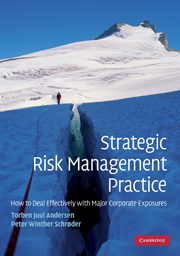Book contents
- Frontmatter
- Contents
- List of abbreviations
- List of figures
- List of tables
- List of boxes
- Preface
- 1 The strategic nature of corporate risk management
- 2 Economic exposures in corporate risk management
- 3 Managing market-related business exposures
- 4 Extending the risk management perspective
- 5 Integrative risk management perspectives
- 6 Current risk management practice and the rise of ERM
- 7 Strategic risk analyses
- 8 Strategic risk management – amendments to the ERM framework
- 9 Strategic risk management
- 10 Postscriptum
- Appendices
- Appendix 1 A strategic responsiveness model
- Appendix 2 Determining the premium on a call option
- Appendix 3 Determining the value of a real option
- Index
Preface
Published online by Cambridge University Press: 05 June 2012
- Frontmatter
- Contents
- List of abbreviations
- List of figures
- List of tables
- List of boxes
- Preface
- 1 The strategic nature of corporate risk management
- 2 Economic exposures in corporate risk management
- 3 Managing market-related business exposures
- 4 Extending the risk management perspective
- 5 Integrative risk management perspectives
- 6 Current risk management practice and the rise of ERM
- 7 Strategic risk analyses
- 8 Strategic risk management – amendments to the ERM framework
- 9 Strategic risk management
- 10 Postscriptum
- Appendices
- Appendix 1 A strategic responsiveness model
- Appendix 2 Determining the premium on a call option
- Appendix 3 Determining the value of a real option
- Index
Summary
Today's institutions and the executives who lead them must be able to demonstrate an ability to deal with frequent and often abrupt changes fuelled by new market developments, political events, technological inventions and different environmental hazards that confront their activities across the global economy. These risks affect the activities of large, multinational corporations, medium-sized enterprises and small commercial entities alike and thereby also affect public institutions and the very communities they operate in. In short, the underlying risk management concerns have wide ramifications and consequently apply to a wide constituency, including both private and public institutions as well as policy makers who care about the wider consequences of risk. Accordingly, there has been a tremendous increase in the public focus on ‘corporate risk’ in recent years. A predominant reason for the increased recognition of risk undoubtedly lies in the higher frequency of major risk events over the past decade, some of which have had severe repercussions for exposed organizations, with a potential to affect severely economic activity at large. Many corporate incidents have hit the newspaper headlines. These include scandals like the diversion of funds from the Maxwell companies in the early 1990s; the rogue trader, Nick Leeson, who brought the Barings Bank to extinction in the mid-1990s; Bernie Ebbers, the former Chief Executive Officer, who committed major accounting frauds in his company WorldCom from the late 1990s; and Kenneth Lay, Chairman, and Jeffrey Skilling, the CEO of Enron, who submitted misleading annual reports that preceded the company's eventual collapse in the early 2000s.
- Type
- Chapter
- Information
- Strategic Risk Management PracticeHow to Deal Effectively with Major Corporate Exposures, pp. xvii - xxiiPublisher: Cambridge University PressPrint publication year: 2010



